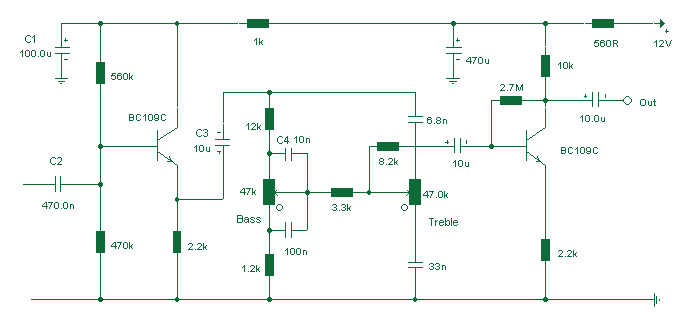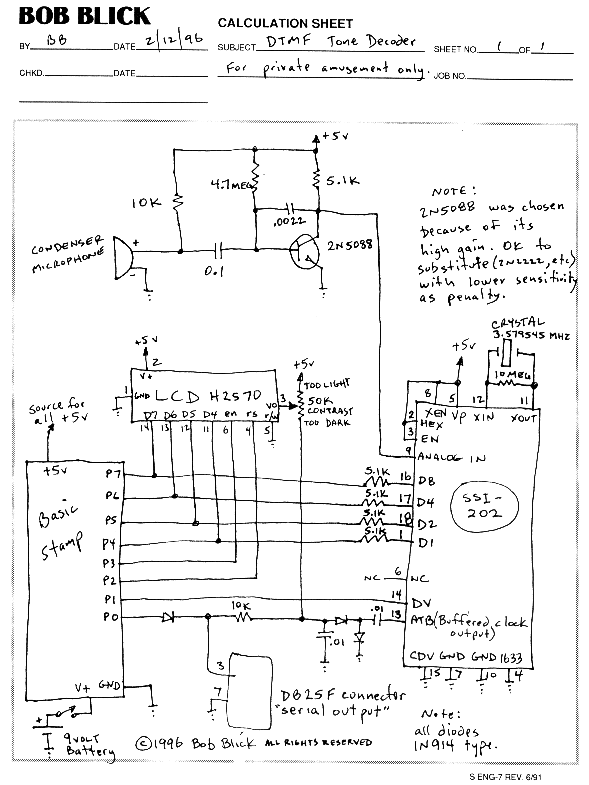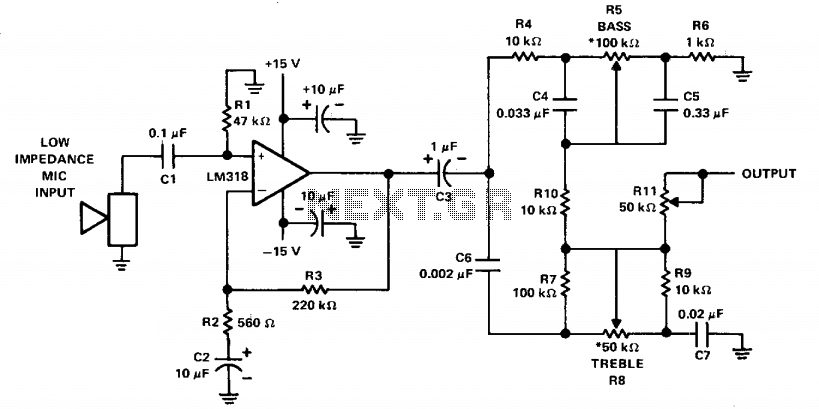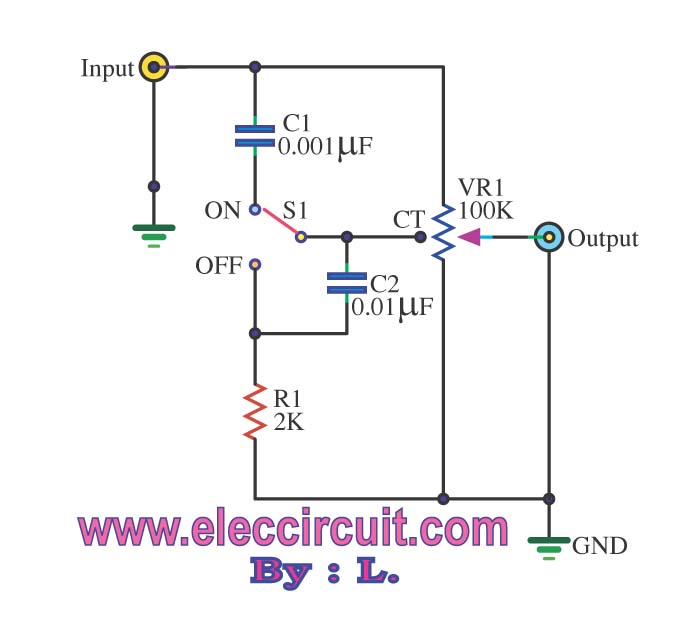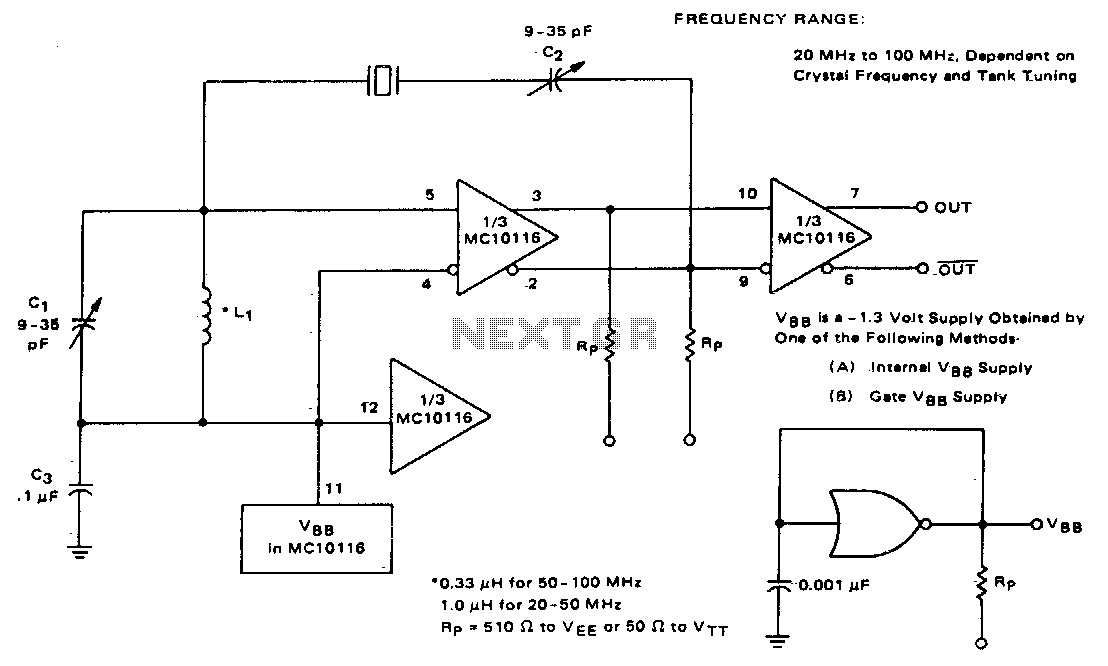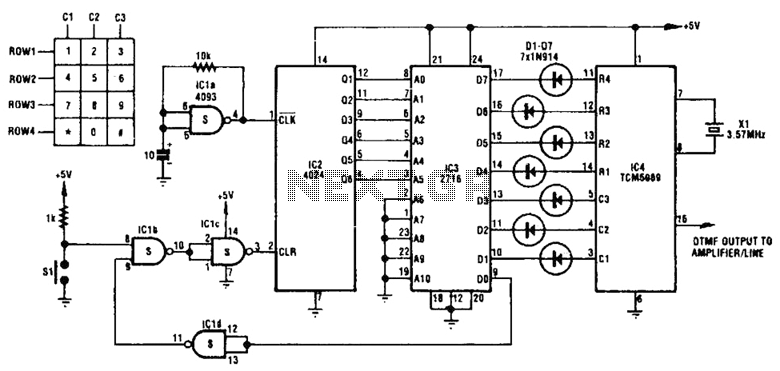
Tone Controls
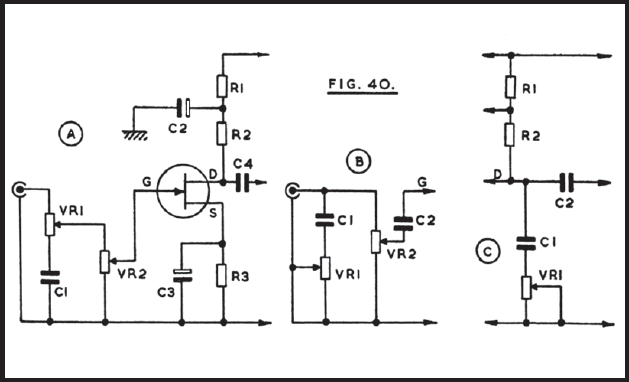
The circuit operates from a 12V or similar power supply, with the option to adjust resistor R1 for higher voltage applications. There is significant flexibility in selecting values for components like capacitor C1. At point B, VR1 serves as a treble cut control, while VR2 functions as the volume control. Capacitor C2 connects to gate G, with a 2.2 megohm resistor providing the DC path from the gate to the negative line. Other components include R1, R2, P3, C2, C3, and C4 as indicated at point A. An additional treble cut control is located at point C, where R1 and R2 mirror the values used at point A, with C2 from point A also incorporated. This tone control can often be added to existing stages without disrupting the circuit board. C1 at point C may be set to 47nF, and VR1 is typically 25k, although higher values can be used for VR1, which may limit the effective range of the control. Increasing C1 can enhance the treble cut effect. The performance of various component values is influenced by the circuit's impedance. C1 acts as the input isolating capacitor and may be unnecessary with certain input types. VR1 adjusts treble levels; moving the wiper towards C2 raises treble as its reactance decreases with frequency, while moving towards C3 reduces treble. VR2 similarly adjusts bass levels. Both VR1 and VR2 are linear controls that feed into volume control VR3 through R1. The source and drain circuits for the FET can be configured as shown in Figure 40. While component values can be somewhat flexible, using components that provide extreme cut or boost is generally unnecessary. Maintaining a roughly flat response with VR1 and VR2 in the center position is advantageous.
The circuit described is a versatile audio control system designed to manipulate treble and bass frequencies while managing overall volume. The power supply requirement of 12V suggests compatibility with common audio equipment. The adjustable resistor R1 allows for customization of the circuit to accommodate higher voltage sources, enhancing the circuit's adaptability.
VR1 and VR2, as treble and volume controls respectively, utilize linear potentiometers, which provide a smooth transition in audio levels. The inclusion of C1 as an input isolating capacitor serves to prevent DC offset from affecting subsequent stages, promoting clearer audio reproduction. The choice of a 47nF capacitor for C1 is standard for audio applications, ensuring adequate bandwidth while preventing low-frequency noise from entering the circuit.
The configuration of the FET's source and drain circuits, as referenced in Figure 40, is critical for optimal performance. The FET's characteristics, including its transconductance and threshold voltage, will influence the overall gain and frequency response of the circuit. The use of a 2.2 megohm resistor at the gate ensures that the FET operates within its linear region, providing a stable DC operating point while allowing for AC signal processing.
The design allows for flexibility in component selection, which is essential in audio applications where personal preference plays a significant role. The ability to fine-tune the treble and bass response through VR1 and VR2 ensures that users can achieve their desired sound profile. Additionally, the potential for integrating this tone control into existing circuits without major modifications enhances its utility in various audio setups.
Overall, this circuit exemplifies a well-thought-out approach to audio signal processing, balancing flexibility, usability, and performance, making it suitable for both amateur and professional audio applications.Operation is from a 12v or similar supply, and R1 can be changed if necessary for higher voltages. In this and similar circuits there is considerable latitude in the choice of values for positions such as C1. At B VR1 is a top cut control, and VR2 the volume control. C2 is connected to the gate at G, and a 2. 2 megohm resistor provides the DC path from gate to negative line, other components being R1, R2, P3, C2, C3 and C4 as at A. Yet another top cut control is shown at C. Here, R1 and R2 are the some as R1 and R2 in A, C2 of A being included as at A. In some cases such a tone control can be added to an existing stage without any disturbance to the circuit board. C1 at C can be 47nF, and VR1 25k. Higher values may be fitted for VR1, but tend to make most of the audible effect of this control occupy only a small part of its rotation.
C1 can be increased, to give increased top cut. The results obtained with various component values are influenced by the impedance of the circuit. C1 is the input isolating capacitor, and may be unnecessary with some types of input. VR1 is for treble control. Treble is lifted with the wiper towards C2, whose reactance falls as frequency rises. With VR1 wiper towards C3, treble is reduced. VR2 similarly provides lift or cut in bass. Both are linear controls, supplying the volume control VR3 by means of R1. The source and drain circuits for the FET can be as in Figure 40. Again, values are to some extent a matter of choice, but there is little point in using components which will provide extreme degrees of cut or boost, which wilt never be required. It is also of advantage to have approximately flat reproduction with VR1 and VR2 central. 🔗 External reference
The circuit described is a versatile audio control system designed to manipulate treble and bass frequencies while managing overall volume. The power supply requirement of 12V suggests compatibility with common audio equipment. The adjustable resistor R1 allows for customization of the circuit to accommodate higher voltage sources, enhancing the circuit's adaptability.
VR1 and VR2, as treble and volume controls respectively, utilize linear potentiometers, which provide a smooth transition in audio levels. The inclusion of C1 as an input isolating capacitor serves to prevent DC offset from affecting subsequent stages, promoting clearer audio reproduction. The choice of a 47nF capacitor for C1 is standard for audio applications, ensuring adequate bandwidth while preventing low-frequency noise from entering the circuit.
The configuration of the FET's source and drain circuits, as referenced in Figure 40, is critical for optimal performance. The FET's characteristics, including its transconductance and threshold voltage, will influence the overall gain and frequency response of the circuit. The use of a 2.2 megohm resistor at the gate ensures that the FET operates within its linear region, providing a stable DC operating point while allowing for AC signal processing.
The design allows for flexibility in component selection, which is essential in audio applications where personal preference plays a significant role. The ability to fine-tune the treble and bass response through VR1 and VR2 ensures that users can achieve their desired sound profile. Additionally, the potential for integrating this tone control into existing circuits without major modifications enhances its utility in various audio setups.
Overall, this circuit exemplifies a well-thought-out approach to audio signal processing, balancing flexibility, usability, and performance, making it suitable for both amateur and professional audio applications.Operation is from a 12v or similar supply, and R1 can be changed if necessary for higher voltages. In this and similar circuits there is considerable latitude in the choice of values for positions such as C1. At B VR1 is a top cut control, and VR2 the volume control. C2 is connected to the gate at G, and a 2. 2 megohm resistor provides the DC path from gate to negative line, other components being R1, R2, P3, C2, C3 and C4 as at A. Yet another top cut control is shown at C. Here, R1 and R2 are the some as R1 and R2 in A, C2 of A being included as at A. In some cases such a tone control can be added to an existing stage without any disturbance to the circuit board. C1 at C can be 47nF, and VR1 25k. Higher values may be fitted for VR1, but tend to make most of the audible effect of this control occupy only a small part of its rotation.
C1 can be increased, to give increased top cut. The results obtained with various component values are influenced by the impedance of the circuit. C1 is the input isolating capacitor, and may be unnecessary with some types of input. VR1 is for treble control. Treble is lifted with the wiper towards C2, whose reactance falls as frequency rises. With VR1 wiper towards C3, treble is reduced. VR2 similarly provides lift or cut in bass. Both are linear controls, supplying the volume control VR3 by means of R1. The source and drain circuits for the FET can be as in Figure 40. Again, values are to some extent a matter of choice, but there is little point in using components which will provide extreme degrees of cut or boost, which wilt never be required. It is also of advantage to have approximately flat reproduction with VR1 and VR2 central. 🔗 External reference
Warning: include(partials/cookie-banner.php): Failed to open stream: Permission denied in /var/www/html/nextgr/view-circuit.php on line 713
Warning: include(): Failed opening 'partials/cookie-banner.php' for inclusion (include_path='.:/usr/share/php') in /var/www/html/nextgr/view-circuit.php on line 713
